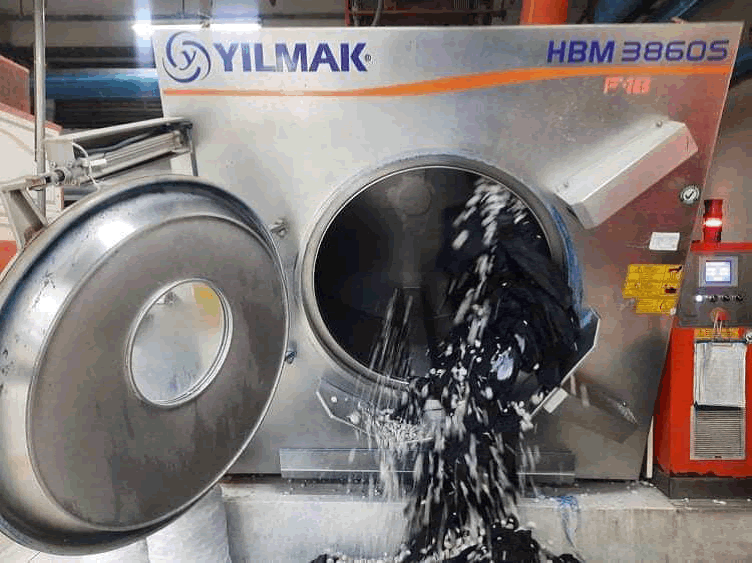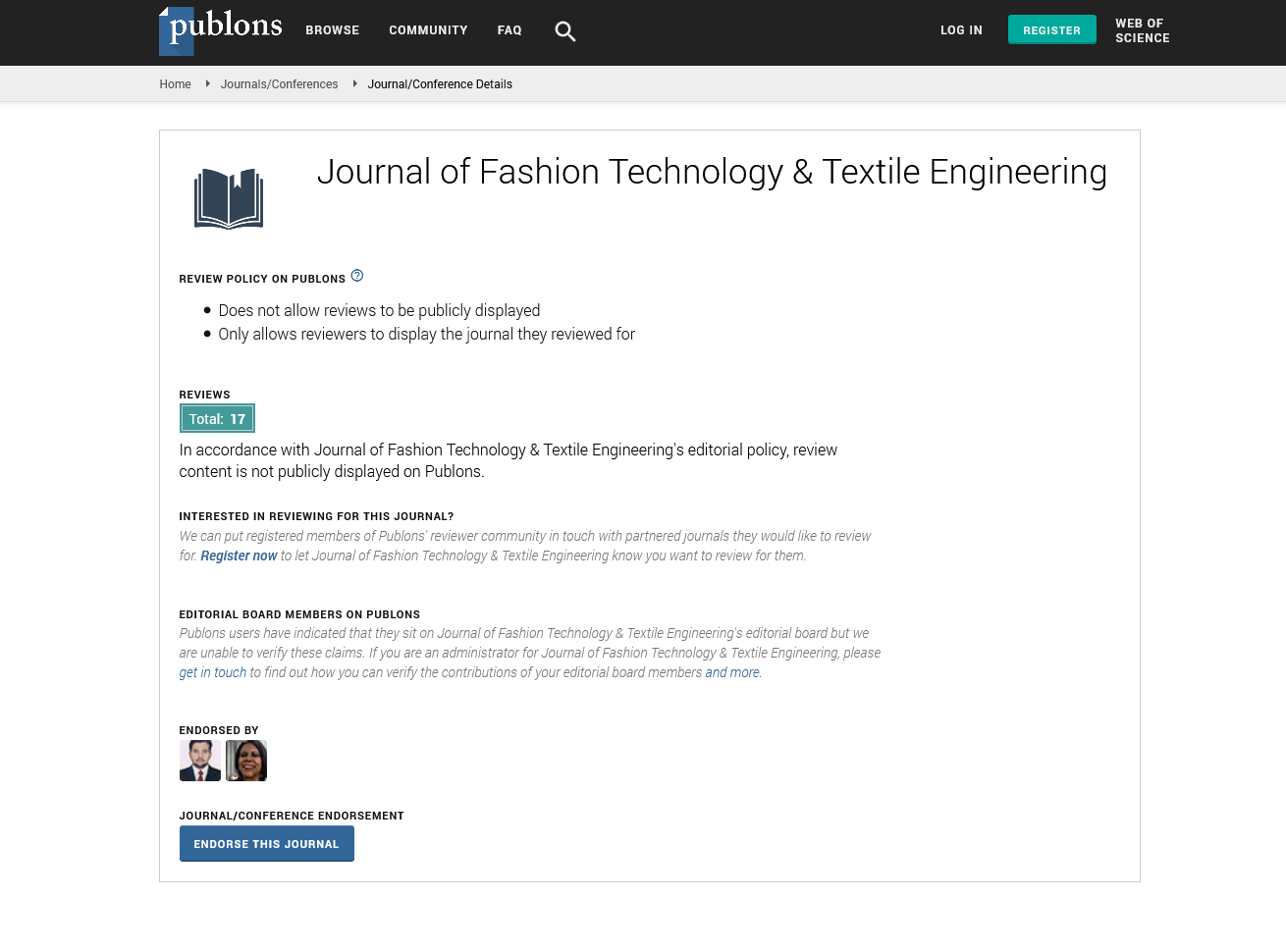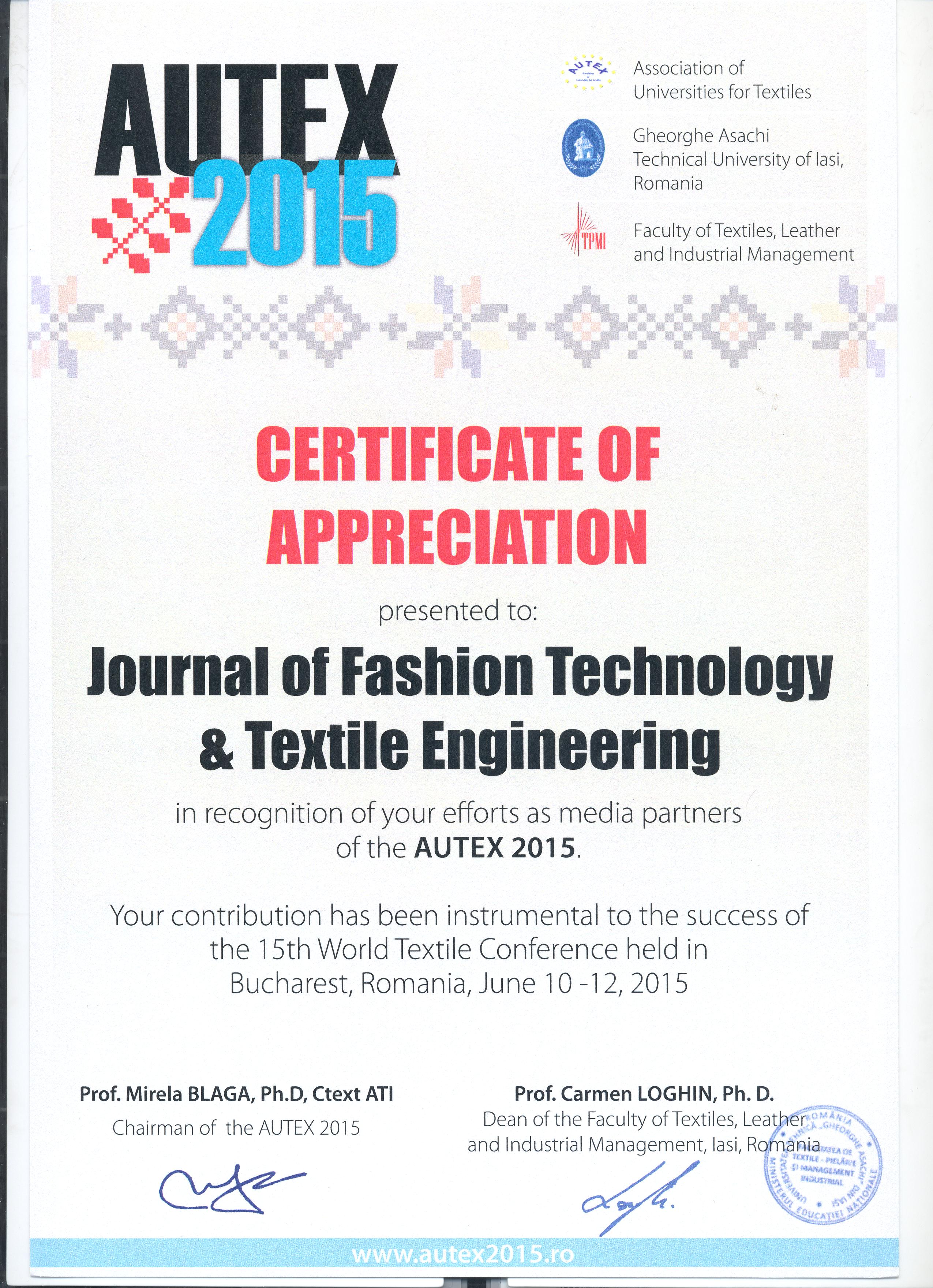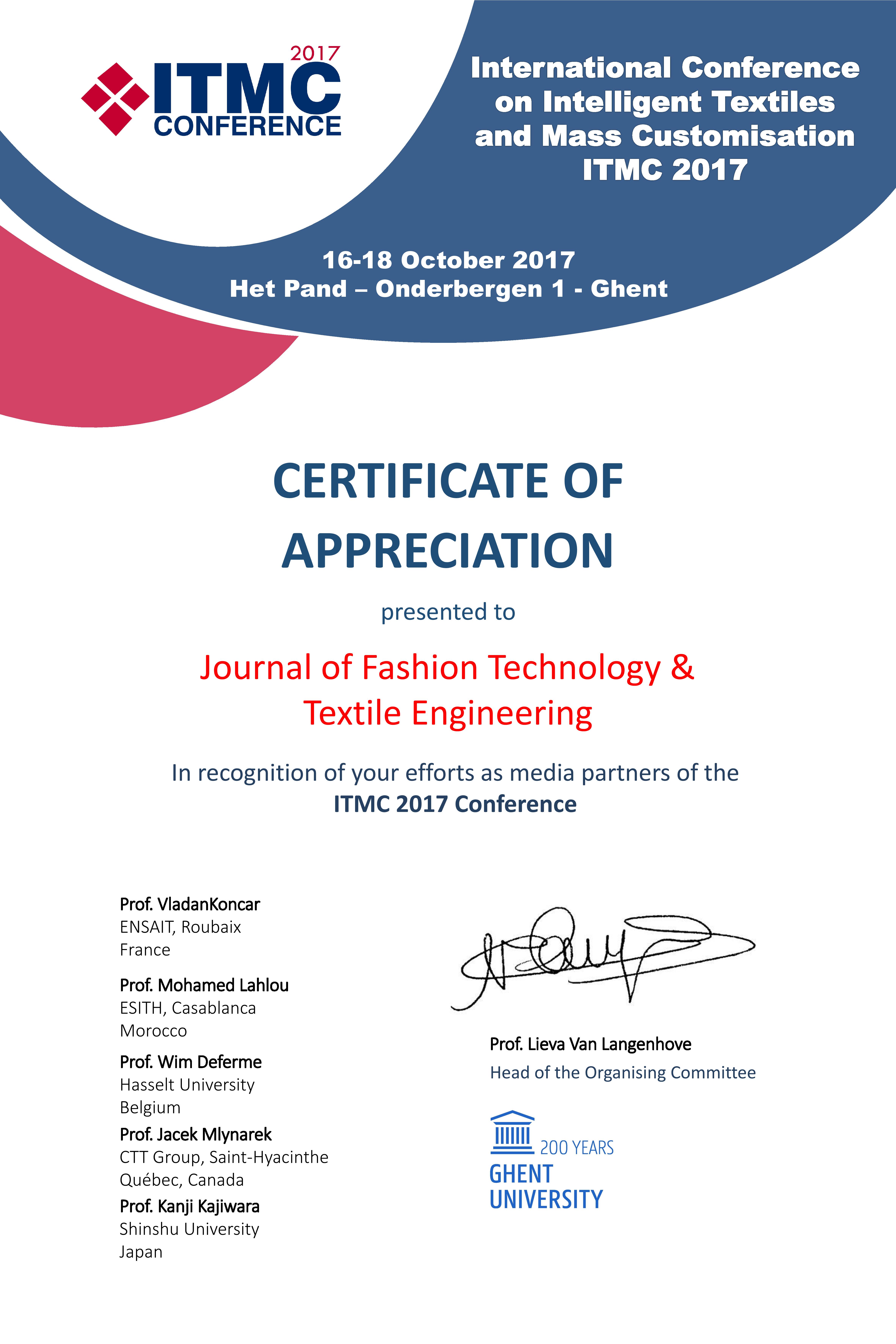Review Article, J Fashion Technol Textile Vol: 13 Issue: 1
Garment Washing and Its Impact on Water Pollution: A Comprehensive Review
Indrani Dhar*
Department of Textile Engineering, Port City International University, Chittagong,
Bangladesh
*Corresponding Author:Indrani Dhar
Department of Textile Engineering, Port City International University, Chittagong, Bangladesh
E-mail: artisancanvas662@gmail.com
Received date: 12 October, 2023, Manuscript No. JFTTE-23-116400;
Editor assigned date: 16 October, 2023, PreQC No. JFTTE-23-116400 (PQ);
Reviewed date: 30 October, 2023, QC No. JFTTE-23-116400;
Revised date: 17 January, 2025, Manuscript No. JFTTE-23-116400 (R);
Published date: 24 January, 2025, DOI: 10.4172/2329-9568.1000392
Citation: Dhar I (2025) Garment Washing and Its Impact on Water Pollution: A Comprehensive Review. J Fashion Technol Textile 13:1.
Abstract
Garment washing is an integral part of the textile and fashion industry, enhancing the appearance and texture of textiles, and meeting consumer demands for unique and trendy clothing. However, the extensive use of chemicals, water, and energy in the garment washing process has raised significant concerns regarding its environmental impact, particularly in terms of water pollution. This review paper explores the various methods and techniques of garment washing, the chemicals involved, and their effects on water quality. It also discusses the regulatory frameworks, sustainable alternatives, and potential future directions to mitigate water pollution caused by garment washing processes. Garment washing relies heavily on chemicals, dyes, and detergents, which, when inadequately managed, find their way into water bodies, severely impacting aquatic ecosystems. These substances often include hazardous compounds like heavy metals and carcinogenic agents, posing significant threats to both aquatic life and water quality. Microplastic pollution is another critical facet of this issue, with synthetic fibers shedding during laundry infiltrating water systems, endangering marine life, and potentially entering the human food chain. The environmental toll extends to high energy consumption, as traditional washing machines consume substantial electricity and water resources. This not only strains energy supplies but also exacerbates water scarcity, compounding existing challenges in regions prone to such issues.
Keywords: Garment washing; Textile; Fashion industry; Chemicals
Introduction
Garment washing is a pivotal stage in textile production, but its environmental toll on water pollution is profound. This comprehensive review delves into the multifaceted dimensions of this issue. The extensive use of chemicals, dyes, and detergents in garment washing contributes significantly to water pollution. When inadequately managed, these substances find their way into water bodies, posing severe risks to aquatic ecosystems. Hazardous chemicals, including heavy metals and carcinogenic compounds, can accumulate and harm aquatic life. Micro-plastic pollution is another dire consequence of garment washing. Tiny synthetic fibers shed during laundering infiltrate water systems, contaminating marine environments and potentially entering the human food chain (Figure 1) [1].
Figure 1: On-going operation of garments wet process.
Energy consumption adds to the problem. Traditional washing machines consume substantial electricity and water, straining energy resources and exacerbating water scarcity in regions where it is already an issue. Furthermore, the discharge of untreated or partially treated wastewater from textile industries is detrimental. It often contains organic matter, colorants, and chemicals that deplete oxygen levels in water bodies, leading to ecosystem disruption. Nowadays, denim is popular. To make denim seem beautiful, many cleaning methods are utilized. Varying denim washing methods produce varying waste. Methods affect the environment. This study examines denim washing effluents' environmental impact. Six washes: Desizing, enzyme, stone, bleach, acid, and random. Effluent testing evaluates washing's environmental and textile impacts. Enzyme wash got the greatest GSM because enzymes are unique. They degrade cellulose's surface color, not content. Shrinkage raises GSM. Washing did not alter fabric thickness, pilling, or elongation. Alkaline washing reduces textile deterioration, making enzyme and desize wash strong. Fabric stiffness decreases with stone, bleach, and acid wash, increasing the crease recovery angle. Enzyme and desize wash reduce wastewater TDS. These methods reduce denim's indigo tint. This method decreases water contamination, simplifying wastewater treatment [2].
Addressing these challenges requires industry-wide efforts, including adopting sustainable practices such as energy-efficient machinery, eco-friendly dyes, and advanced wastewater treatment. Consumers can also contribute by adopting responsible laundering habits and supporting brands committed to eco-conscious production. Garment washing is integral to the textile industry, but its adverse impact on water pollution necessitates a concerted commitment to more sustainable and environmentally friendly practices, involving stakeholders from production to consumption.
Literature Review
Methods and techniques of garment washing
Upgrades have made denim a fashion staple in recent decades. Modern consumers value comfort, economy, and the environment in clothing. Sustainable, non-toxic, biodegradable mechanical and chemical wet and dry denim washing processes are popular. Used for denim and casual garments. Without garment cleaning technology, hand feel and apparel comfort decline, lowering user satisfaction. Improves garment quality cheaply. Whiskering, hand-sanding, grinding, and destroying are eco-friendly dry-cleaning procedures. Stonewash, enzyme-stone wash, super whitewash, bleach wash, acid wash, and enzyme-stone wash employ a few hazardous colors and chemicals. This study examined many clothing's dry and moist processes. Eco-friendly denim washing equipment, SOPs, and procedures existed. With limited worldwide resources, garment makers and washing technologists can diversify apparel markets [3].
Stone washing: Stone washing is a textile finishing process that imparts a worn and distressed appearance to denim and other fabrics. It involves tumbling garments with abrasive stones, typically pumice or volcanic rock, in large industrial machines. The stones abrade the fabric's surface, creating a faded, soft, and vintage look by removing some of the dye and breaking down the fibers. This technique gained popularity in the 1980's as a way to achieve the "lived-in" aesthetic of well-worn jeans. Today, it remains a vital part of denim manufacturing, offering both fashion and environmental benefits by reducing the need for chemical treatments while creating unique and fashionable textures. Because practically all companies produce trash, eliminating it is necessary for environmental regulations and future animal welfare. In this study, denim washing mill waste pumice stones are used to remove pollutants and make money by turning them to adsorbents. Adsorption eliminated contaminants from three factory waste water treatment system effluents.
Acid washing: Acid washing is a textile treatment process primarily used on denim and other fabrics to create a distinct and faded appearance. It involves the use of chemicals, typically a mixture of chlorine and pumice stones, to strip away the top layer of dye from the fabric. This process results in a weathered, worn-out look with areas of lighter and darker shades. Acid washing gained popularity in the 1980s as a fashion trend, known for its bold and edgy aesthetic. While it has evolved over the years, acid washing remains a technique employed to achieve unique and distressed designs in the world of fashion and denim manufacturing. The enzymatic wash produced the most MF, with 1423 MF/g equivalent to 381.7 MF grams per gram of cloth (MF g/g), followed by the acid wash with 253 and the rinse wash with 133 and 62.3, respectively. Emissions by MF/g showed statistically significant differences between MF sizes for all washing processes [5].
Enzyme washing: Enzyme washing is a textile finishing process used to enhance the softness and texture of fabrics, particularly denim. Instead of abrasive methods like stone or acid washing, enzymes are employed to break down and remove excess fibers on the fabric's surface. These enzymes, typically derived from natural sources like bacteria or fungi, target cellulose fibers without harming the fabric itself. Enzyme washing is known for its eco-friendly and gentle approach, reducing the need for harsh chemicals and water consumption in the finishing process. It results in a smoother, softer, and more comfortable fabric, often used in creating vintage or distressed denim looks while minimizing environmental impact.
Bleach washing: Bleach washing, often known as bleaching, is a method of treating textiles that involves the use of bleach to remove color from or lighten them. It is often used in the fashion industry, especially for denim, to create special and trendy results. Bleach washing is applying a diluted bleach solution to the cloth by spraying it on, brushing it on, or soaking it. Distressed, vintage, or tie-dye effects can be achieved by using bleach to remove or fade the dye in certain areas. Careful execution is required because too much bleach might weaken the fabric and ruin the design possibilities. Bleach washing is a common method for creating a variety of trendy and eyecatching garment effects.
Vintage washing: A vintage wash gives the appearance that a fabric, often denim, has been worn and used for a long time and originates from another era. This effect can be achieved by applying the wash during the finishing process. The effect that you want to get with this procedure is one that is analogous to that of clothing that has been worn and gently worn over the course of time. In order to attain the desired results from vintage cleaning, it is common practice to combine a number of different washing techniques, such as enzyme washing, stone washing, and hand-sanding, among others. The finished product is clothing that has a classic, well-worn appearance while also retaining a modern and unique character. The fashion industry frequently makes use of historical washing procedures in order to imbue modern things with an air of allure and melancholy.
Sand blasting: The textile and fashion industries frequently employ the abrasive finishing procedure of sand blasting, especially for denim clothes. The process involves blasting the cloth with a stream of high-pressure air that carries fine sand or abrasive particles. This abrasive process efficiently eliminates the fibers' outermost coating, giving the material a weathered or distressed look. Sand blasting's intensity is adjustable, so you may create your own level of wear and tear. Environmental concerns have reduced its use in recent years since the process creates hazardous dust and endangers the health of employees. To get the same results without the downsides of sandblasting, many producers have switched to more eco-friendly alternatives including enzyme washing and laser methods. Whiskering precedes hand sanding. The process ensures a worn-out appearance on denim clothes. Use abrasive paper, a horizontal air dummy, and gum tape. This procedure is preferred over sand blasting due to its health risks [3].
Laser and ozone technologies: The utilization of lasers and ozone in the process of textile finishing and garment manufacture represents a state-of-the-art and environmentally sustainable methodology. Lasers possess the capability to accurately vaporize or eliminate specific portions of various materials, including denim or cloth. This rigorous and regulated approach enables the creation of intricate patterns, distressing, and fading effects, all achieved without the need for water, chemicals, or abrasive techniques. The alternative finishing approach is considerably more efficient compared to traditional techniques, resulting in a reduced environmental footprint.
Nevertheless, ozone technology utilizes ozone gas to achieve similar objectives such as bleaching, fading, and softening the fabric. Compared to conventional bleaching methods, this choice is more environmentally sustainable due to its reduced water use and avoidance of potentially hazardous chemicals. The presence of ozone can contribute to the reduction of water pollution and energy consumption in the textile sector.
Laser and ozone technologies possess desirable attributes like as efficiency, versatility, and environmental friendliness, rendering them very suitable resources for the creation of attractive and durable clothes.
Discussion
Impact of garment washing on water pollution
Chemical runoff: Chemical runoff from garment washing is a significant environmental concern. During processes like stone washing, acid washing, or dyeing, chemicals, detergents, and dyes are used extensively. When excess chemicals are not properly treated or removed from wastewater, they enter rivers and water systems, causing pollution and harm to aquatic life.
These chemicals can disrupt ecosystems, degrade water quality, and even pose health risks to humans. To mitigate this issue, many textile manufacturers are adopting more sustainable practices, such as closedloop systems, where water and chemicals are continuously recycled and treated, and minimizing environmental impact. Consumer awareness and support for eco-friendly and responsible garment production are also driving positive change in the industry.
Micro-plastic release: Micro-plastic release from garments during washing is a growing environmental concern. Many fabrics, especially synthetic ones like polyester and nylon, shed tiny plastic particles when laundered. These micro-plastics can't be filtered out by wastewater treatment plants, so they end up in rivers and oceans.
Once in the environment, they pose a threat to aquatic life and can eventually enter the food chain, potentially affecting human health. To mitigate this issue, manufacturers are exploring alternative materials, and some washing machine manufacturers are developing filters to trap micro-plastics. Additionally, consumer awareness about sustainable fabric choices and using specialized laundry bags to capture micro-plastics can help reduce their release.
Energy consumption: Energy consumption from garment washing is a significant contributor to environmental impact. Traditional washing machines require substantial electricity and water to heat, agitate, and rinse clothes. The energy intensity of hot water washing further exacerbates this issue. Frequent and inefficient washing not only drives up household energy bills but also contributes to carbon emissions.
To address this, energy-efficient appliances, such as front-loading washing machines and cold-water detergents, are recommended. Additionally, adopting sustainable laundry habits like washing full loads, using shorter wash cycles, and air-drying clothes can significantly reduce energy consumption, minimizing the environmental footprint of garment washing while saving both energy and money. Upgrades have made denim a fashion staple in recent decades. Modern consumers value comfort, economy, and the environment in clothing. Thus, eco-friendly, non-toxic, biodegradable wet processes like super whitewash are becoming more popular. Although unstudied, ultra-white wash technology has expanded denim cleaning consumer and commercial options. Applying to solid fabrics is simple. This study studied washing length, machine rpm, and ultrawhite wash denim fabric physical and chemical changes. It improves textile and garment whitening, K/S, color fastness (washing, light, perspiration), pilling, and handling. Machine rpm and washing reduce fabric tensile, rip, and dimensional stability. Machine rpm and cleaning improved fabric samples' WI, K/S, pilling resistance, handling, and color fastness. A variety of washing conditions affected cloth GSM [1].
Water consumption: Water consumption from garment washing is a significant environmental concern. Traditional washing machines use substantial amounts of water, with some top-loading models using as much as 40 gallons per cycle. The overuse of water during laundry contributes to water scarcity issues in many regions and places undue stress on local ecosystems.
To address this concern, front-loading machines, which generally use less water, are recommended for their efficiency. Additionally, practicing water-saving habits like washing full loads, using highefficiency appliances, and reusing gray water for non-potable purposes can substantially reduce the environmental impact of garment washing, promoting sustainable water use in households. Many appliances have eco-settings to reduce household energy use. The effectiveness of ecosettings in lowering energy use is unclear. Different sustainable behavior techniques like compulsion and feedback may work better [6].
Wastewater discharge: Garment washing generates a lot of wastewater, which is a major environmental problem. Detergents, chemicals, and toxins are washed down the drain or into a body of water without proper treatment. Pollution has a deleterious effect on aquatic ecosystems, lowers water quality, and kills marine life.
Some regions are taking action by enforcing legislation and wastewater treatment standards aimed at decreasing the emission of dangerous pollutants. Sustainable practices are being adopted by ecoconscious consumers. This includes the use of biodegradable detergents and the patronage of apparel manufacturers that place a premium on ethical production methods. These initiatives are working toward a cleaner, more sustainable textile industry by reducing the negative consequences of wastewater discharge from garment washing.
Heavy metal contamination: Heavy metal contamination resulting from garment washing is an emerging environmental concern. Some clothing items, particularly those with metal components like buttons, zippers, or embellishments, can release heavy metals during washing. These toxic substances, including lead, cadmium, and chromium, can leach into wastewater, posing risks to aquatic ecosystems and potentially entering the food chain.
To address this issue, manufacturers are exploring alternative materials and coatings that minimize heavy metal release. Additionally, consumers can take steps to reduce contamination by opting for clothing with fewer metal elements and using specialized laundry bags designed to capture micro-plastics and metals. Awareness and responsible consumer choices are key in combating heavy metal pollution from garment washing. Chitosan was utilized to change fabrics and knits to test polyester structures and treatments on wastewater particulate pollution. Polyester knit composites, chitosanpolyester fabric, and pure polyester was washed cyclically with ECE A detergent at 60°C. Laser diffraction characterized 1–5, 6–10, and 1–10 wash cycle wastewater particle sizes. Total Solids (TS), TSS, TDS, turbidity, and COD were measured according to standard procedures. polyester textiles, knit structures, and chitosan-polyester composites impact washing wastewater PSD. Different curve span value and shape factor (k) indicate particle release during washing. Laser diffraction can characterize washing wastewater particle size for pure polyester and chitosan-polyester composites, according to experiments. Microplastic pollution may be prevented via chitosan modification [7,8].
Conclusion
Garment washing is a fundamental part of the textile industry, providing consumers with fashionable and unique clothing. With washing technology, several Chinese companies are planning to expand their operations to Southeast Asia in order to take advantage of the region's lower labor costs and other advantages. However, the adverse environmental impacts, particularly water pollution, are a growing concern. Efforts to reduce water pollution from garment washing processes should focus on sustainable alternatives, improved regulation, and heightened consumer awareness. By adopting more eco-friendly practices and technologies, the textile and fashion industry can mitigate its contribution to water pollution and move towards a more sustainable and responsible future.
References
- Rahaman MT, Akter S, Pranta AD (2021) Performance optimization of super white washed stretch denim fabric by deviating washing process time and machine RPM. Int J Indus Manu Sys Eng 10: 10.
- Jamshaid H, Rajput AW, Bajwa I, Mujeeb A (2023) Effect of different washing methods on denim fabric properties and their effluent's environmental impact. Mehran University Res J Eng Technol 42: 33-41.
- Hasan MZ, Rahaman MT, Islam T, Pranta AD (2021) An Empirical Analysis of Sustainable Denim Washing Technology in the Apparel Industries. Int J Indus Manu Sys Eng 6: 20.
- Korlu AE, Yapar S, Perincek S, Yilmaz H, Bagıran C (2015) Dye removal from textile waste water through the adsorption by pumice used in stone washing. Autex Res J 15: 158-63.
- Grillo JF, Lopez-Ordaz A, Hernandez AJ, Catari E, Sabino MA, et al. (2023) Synthetic microfiber emissions from denim industrial washing processes: An overlooked microplastic source within the manufacturing process of blue jeans. Sci Total Environ 884: 163815.
[Crossref] [Google Scholar] [PubMed]
- Visser M, Schoormans J (2023) Get rid of the eco-button! Design interventions to steer sustainable use of washing machines. Clean Res Cons 8: 100096.
- Kaurin T, Curlin M, Saravanja A, Vojnovic B, Pusic T (2023) Design of chitosan-polyester composites to reduce particulate contamination of washing wastewater. Water 15: 2418.
- Rahaman MT, Pranta AD, Chandrow O, Das NC, Khatun MD, et al. (2021) COVID-19 pandemic and the future of China-plus-one strategy in apparel trade: A critical analysis from Bangladesh-Vietnam point of view. Open J Business Manag 9: 2183-2196.
 Spanish
Spanish  Chinese
Chinese  Russian
Russian  German
German  French
French  Japanese
Japanese  Portuguese
Portuguese  Hindi
Hindi 



